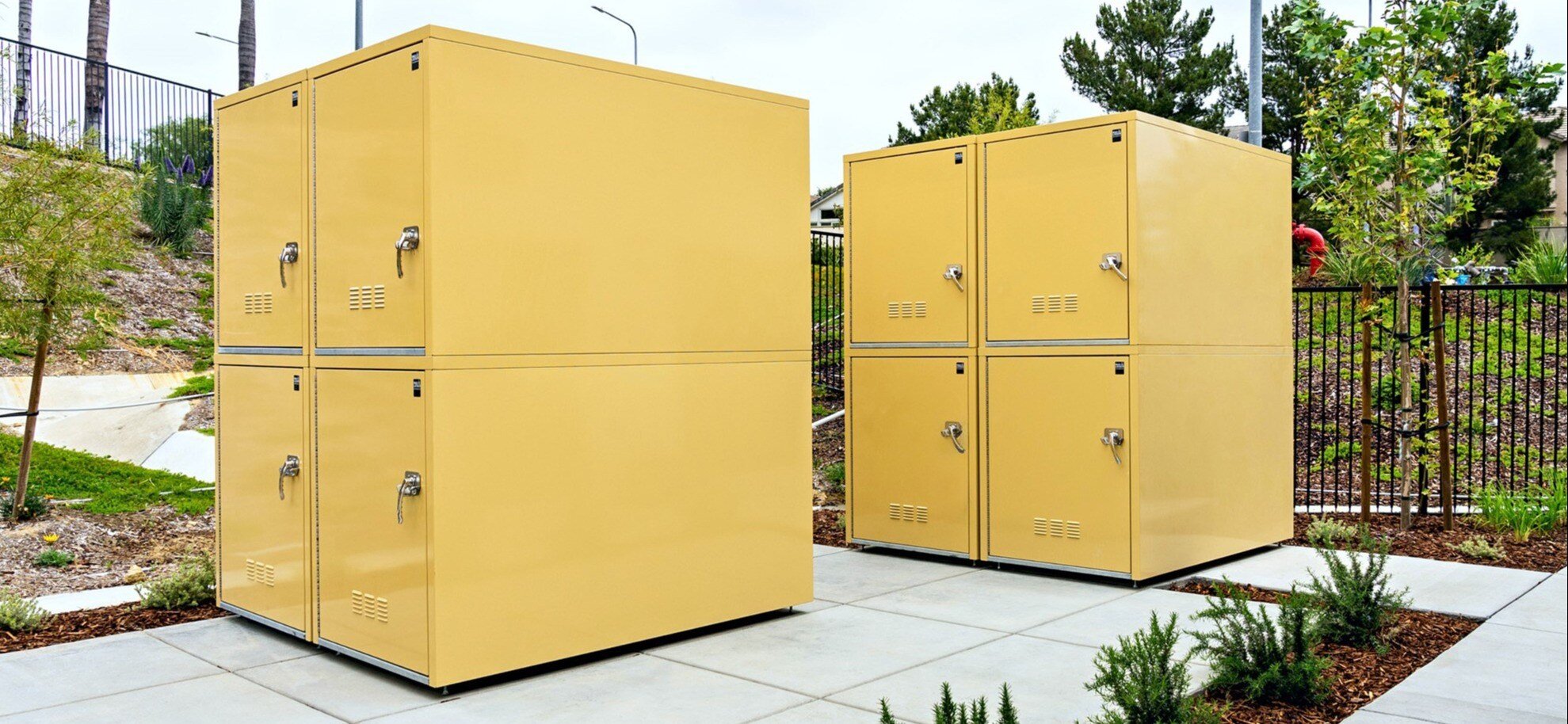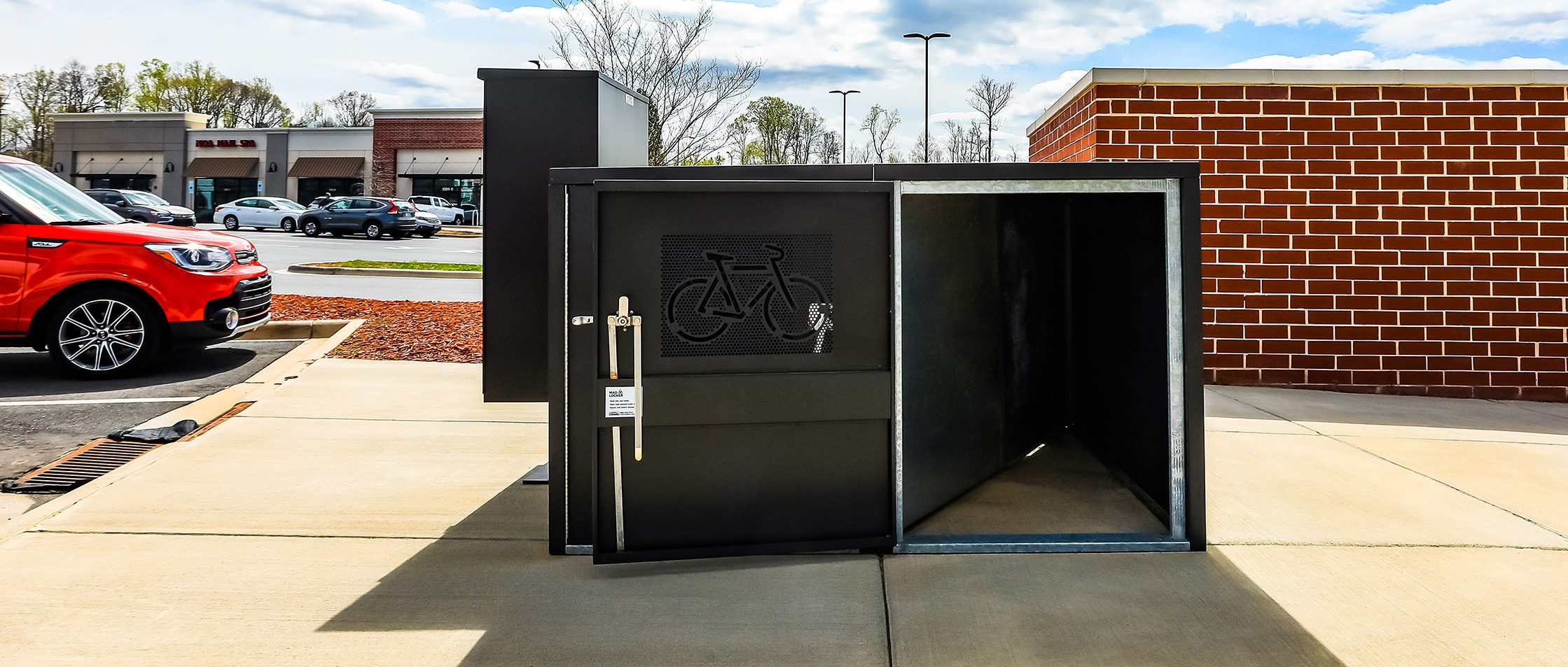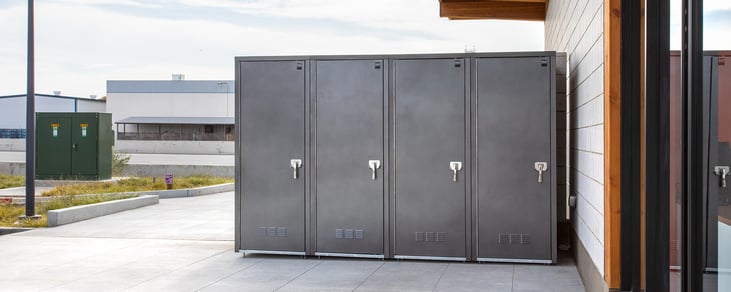Tips for Selecting the Best Bike Locker

When selecting a commercial bike locker, the security it provides is the most important factor. But there are a variety of other considerations – like performance, design, aesthetics, configuration, and installation - when selecting the right locker for your needs. Let's review these different aspects, so you feel confident in making your selection!
Performance
The first point we’re going to look at is performance. To accurately assess how a bike locker will perform, it is important to look at the material it is made from.
Typically , you with see lockers made from either steel or some type of composite.
While composite bike lockers are UV resistant and do not conduct heat, they can also lose durability over time and typically come at a higher price point than steel lockers.
Because of it's durability, cost-effectiveness, and customizable qualities, steel is used for all Madrax bike lockers.
With the right steel components, you can expect the lockers to remain sturdy and secure for many years whether they’re placed in controlled environments or are exposed to weather outside.
Panels, doors, and frame elements should be made of a hot-dipped galvanized steel with a powder-coat top coat.
Locking mechanisms, handles, and other components should be a stainless steel.
As these are the working parts of the bike locker, the higher quality of steel will keep these functioning for years. Because our lockers are made of mechanical components, you will never have to worry about a technological malfunction preventing our doors from opening.
Design & Aesthetics
Turning our attention to design and aesthetics, a bike locker will need to accept most standard-sized bicycles.
Generally, the measurements of a bike locker should be more than the standard bicycle measurements: 72 inches long x 24 inches wide x 46 inches tall.
The interior of the locker should be spacious enough to store the bicycle while also allowing for additional items like bags, helmets and other related accessories.
Catering to these dimensions, bike lockers usually then come in two designs styles – rectangular and pie shaped. They can also be placed in a horizontal or vertical configuration.
Horizontal Bike Lockers
With horizontal bike lockers, the unit is typically accessible from the ground, where the door can be opened and the bicycle can be rolled directly into the locker. The storage capacity of each unit can differ depending on the style of locker.
For reference, a Narrow MadLocker from Madrax measures 31 inches wide and can store a single bicycle along with some additional small items such as a helmet or backpack.
The MadLocker, by comparison, measures at 39 inches wide.
The MadLocker can also be configured to store two bicycles (see above). A diagonal partition, along with a door on each end, is used to create the two triangular parking spaces inside the locker. This is the most cost-efficient way to maximize the number of bike locker parking spaces.
Horizontal bike lockers can also be stacked. Allowing you to maximize the number of bicycles that can be parked per square foot.
Be aware, however, that stacking lockers requires lifting and lowering a bicycle from the upper level, which may make this type of storage difficult for certain users.
Vertical Bike Lockers
Vertical bike lockers are best for minimizing the floor space needed to install bike lockers.
These lockers are a few inches taller than horizontal bike lockers are long. The extra space is needed so the bicycle can be lifted onto a hook that can hold it in the vertical position.
This type of locker also requires the cyclist to lift the bicycle for storage, which may limit the use by some cyclists.
Custom Bike Locker Options
Beyond the standard features of bike lockers, there are some customization options available.
Perforation and cutouts on doors can be customized. This is commonly used for branding, advertising, and to match existing designs.
The powder coat color of your bike locker can also be customized to match the aesthetic of your space.
Site Considerations
To ensure the success of your layout, make sure there is enough end and side clearance for each bike locker to function properly. The ability for a bicycle to be maneuvered in and around a bike locker is the main concern.
Aisles and corridors around bike lockers should allow for simultaneous users to pass through at once. Be conscious of bike locker door length, and how open doors could impede people traveling through the aisles.
If necessary, be sure that there is sufficient room to lift and lower bicycles into stacked and vertical bike lockers.
Generally, because of their design, bike lockers are built for for in-line or banked configurations. Straight rows of lockers are accomplished by placing rectangular units next to one another. When adhered together with the supplied hardware, it makes an almost seamless, continuous run of lockers.
Pie-shaped lockers installed next to one another form circular shapes. Great for wrapping around exterior corners, following other curvatures or filling empty spaces.
For installation, many steel bike lockers arrive disassembled to save on shipping costs. They will need to be assembled and then placed in the desired location. Locker assembly takes on average 45-60 minutes for two individuals.
Bike lockers also commonly have leveling feet. These can be adjusted to maintain a consistent height across a length of banked lockers.
There are a variety of considerations when evaluating bike lockers. The information in this video should help guide you to selecting the correct one for your application.




